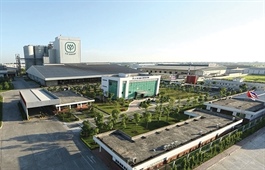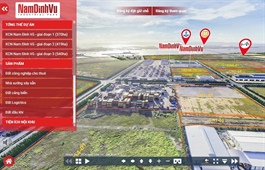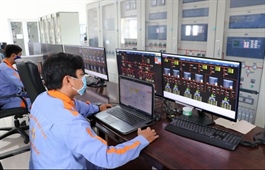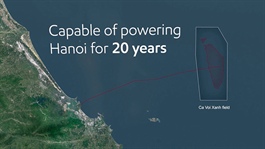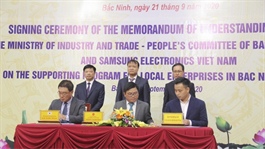Government pushing forward with post-pandemic activities
Government pushing forward with post-pandemic activities
Despite the aftermath of the global health crisis in Vietnam, an optimistic growth scenario is formulated for the next year, with proposals for heavy investment in infrastructure and practical support for the private sector to drive the economy forward and create more employment.
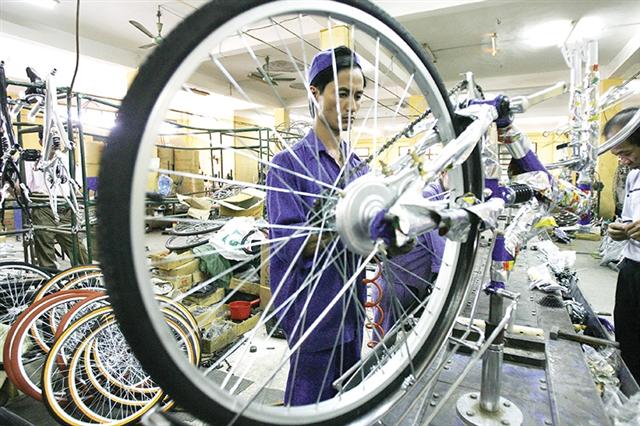
Despite the heavy impact of the pandemic, the Vietnamese government and business community look forward to growth, photo Duc Thanh
|
In April, Nguyen Dinh Chien halted the operation of his second garment factory in Quang Minh Industrial Park in Hanoi’s Dong Anh district due to COVID-19 restrictions. The factory was only inaugurated in the middle of last year.
The previous month, Chien’s first factory faced the same fate. Both factories are managed by Danh Dat Garment and Trading JSC, of which Chien is the director.
However, over the past few weeks the factories, costing VND50 billion ($21.7 million), have begun resuming operations as some big contracts have been landed with local and foreign partners. This means about 500 workers are now receiving incomes.
Danh Dat’s case is among nearly 4,800 enterprises resuming operations in August and also among 32,600 businesses doing the same in the first eight months of 2020, up 27.9 per cent on-year.
Prime Minister Nguyen Xuan Phuc stated, “Local production and business have been gradually recovering, and the number of enterprises resuming operations is rising. However, we are still facing massive difficulties and only expect the economy to bounce back strongly next year.”
The Ministry of Planning and Investment (MPI) expects the economy to grow 2-2.5 per cent this year, with the GDP scale to be VND6.3 quadrillion ($273.9 billion), up VND264 trillion ($11.48 billion) compared to last year.
Under the MPI’s fresh scenario on economic growth for 2021, Vietnam’s GDP for 2021 will increase 6.7 per cent against 2020, at almost VND9.2 quadrillion ($438 billion), with per capita GDP of nearly $3,900.
The total factor productivity’s (TFP) ratio in GDP growth will be 45-47 per cent. Increases in TFP, which is a measure of the efficiency of all inputs in a production process, usually result from technological innovation or improvements. Moreover, labour productivity will climb about 4.8 per cent, and the urbanisation rate will be 40.5-41.5 per cent.
Also under the scenario, next year the economy’s total export-import turnover will be over $554.4 billion, up 5.2 per cent on this year. Of this, the export and import turnovers will rise about 5 and 5.4 per cent, respectively. Total trade surplus will be nearly 2.3 per cent of total export revenue.
To ensure economic growth, the scenario stated that Vietnam’s total power capacity will reach about 67,500MW, up 10.8 per cent against 2020. Produced and imported electricity will hit 227.5 billion kWh, up 10.9 per cent compared to this year.
Beefing up infrastructure
According to the MPI, one of the most drastic measures to ensure this ambitious economic growth of 6.7 per cent for 2021 is to effectively accelerate the construction of infrastructure projects, with the participation of more private investors, while further unlocking the private sector with more practical support to it.
“Efforts are to be made to push up the construction rate of key transport projects such as the eastern cluster of the North-South Expressway, railways, and roads,” stated MPI Minister Nguyen Chi Dung. “We will have to complete and put into operation urban metro lines in Hanoi and Ho Chi Minh City. More investment will be placed in upgrading the Tan Son Nhat, Noi Bai, and Danang international airports, and constructing the first phase of Long Thanh International Airport. We will also upgrade roads, and construct and operate smart traffic management centres.”
In June, the National Assembly adopted a resolution on adjusting the country’s scheme to develop several sections of the North-South Expressway’s eastern cluster. Three out of eight sections will be shifted from the public-private partnership (PPP) investment format to state funding, including Mai Son-National Highway 45 (63km), the Vinh Hao-Phan Thiet Highway (106km), and the Phan Thiet-Dau Giay Highway (98km). The remaining highway projects will use the PPP funding model.
Investors interested in engaging in these projects include local firms Vinaconex, Deo Ca Group, and Tasco, as well as foreign ventures like Hyundai E&C, Taisei, Lotte E&C, and Daewoo E&C.
At a recent meeting between the government and localities, PM Phuc stated that the government will boost the construction of many major infrastructure projects such as the North-South Expressway, Long Thanh International Airport, many highways nationwide, and facilities in the power, water, traffic, and urban development sectors.
“Private investors will be enabled to participate in these projects. This is aimed to boost economic growth and facilitate the attraction of more investment,” he said.
According to the Infrastructure Group of the Vietnam Business Forum, the government’s fresh message is very important, given Vietnam is growing and urbanising swiftly. In order to continue along this trajectory, it needs massive amounts of new infrastructure.
“Vietnam’s public finances are not in a position to supply the capital for such massive new infrastructure development. For such infrastructure to be developed on a sustainable basis over the next years and decades, private capital will be needed,” the group said in a statement. “Private capital will only be provided if the conditions are appropriate.”
Spurring on performance
According to the MPI’s scenario, besides focusing on infrastructure investment, the government will increase attracting private investments to reach the growth target for 2020 via “strongly developing the private economic sector, boosting the links between domestic enterprises and foreign ones. Medium- and large-sized enterprises are encouraged to develop stronger.”
It will also “continue boosting freedom and safety in conducting business and investment; cutting and removing and business conditions; and increasing administrative reforms. Also, the e-government among ministries, agencies, and localities are to be pushed up in state management over enterprises, with a rise in public online services.”
The Korea Chamber of Business in Vietnam’s vice-chairman Hong Sun told VIR that the current time is “dangerous and extremely difficult” for all enterprises, including the 9,000 South Korean ones employing over one million Vietnamese labourers.
“While enterprises are finding it hard to boost exports, it is also extremely difficult for them to expand domestic consumption as consumers are currently tightening their belt for fear of unemployment and reduced incomes caused by COVID-19,” Sun said. “Enterprises are in need of government support.”
The MPI’s General Statistics Office (GSO) is conducting the second national-level survey over the pandemic’s impacts on local production and business in all sectors. The survey covers how enterprises are performing and how far the country’s support for them has gone.
Results of the survey will be released late this month, helping the government and the National Assembly to devise sturdy support for businesses.
Under the first survey conducted in April, 86 per cent of nearly 126,600 surveyed enterprises said they were heavily hit by COVID-19, with the industrial and construction sector and the service sector suffering the most (86.1 and 85.9 per cent, respectively), followed by the agro-forestry-fishery sector (78.7 per cent). Some economic sectors also suffered heavily, including aviation (100 per cent), hospitality (97 per cent), catering (95.5 per cent), travel agencies (95.7 per cent), and education and training (94 per cent).
The GSO reported that in the first eight months of 2020, Vietnam saw 34,300 enterprises halting operations, up 70.8 per cent on-year; some 24,200 businesses awaiting to be dissolved, and another 10,400 completed dissolution procedures. Moreover, 30,600 enterprises were not operating at their registered addresses, up 39.3 per cent on-year.
As for Danh Dat Garment and Trading JSC, director Chien told VIR that he has heard about the government and the National Assembly discussing ways out for enterprises and investors.
“Though our company has begun to recover, we are now facing a big debt from banks. Will we be able to defer loan payments and secure more loans to revive the factories?” Chien wondered.
Last week he visited a bank to discuss such deferral, but failed as he has done the same for several times in the last few months. “The bank said it is now bogged down in difficulties and needs to recoup loans, so debtors like our companies will have to pay back loans and lending rates as soon as possible,” he said.




